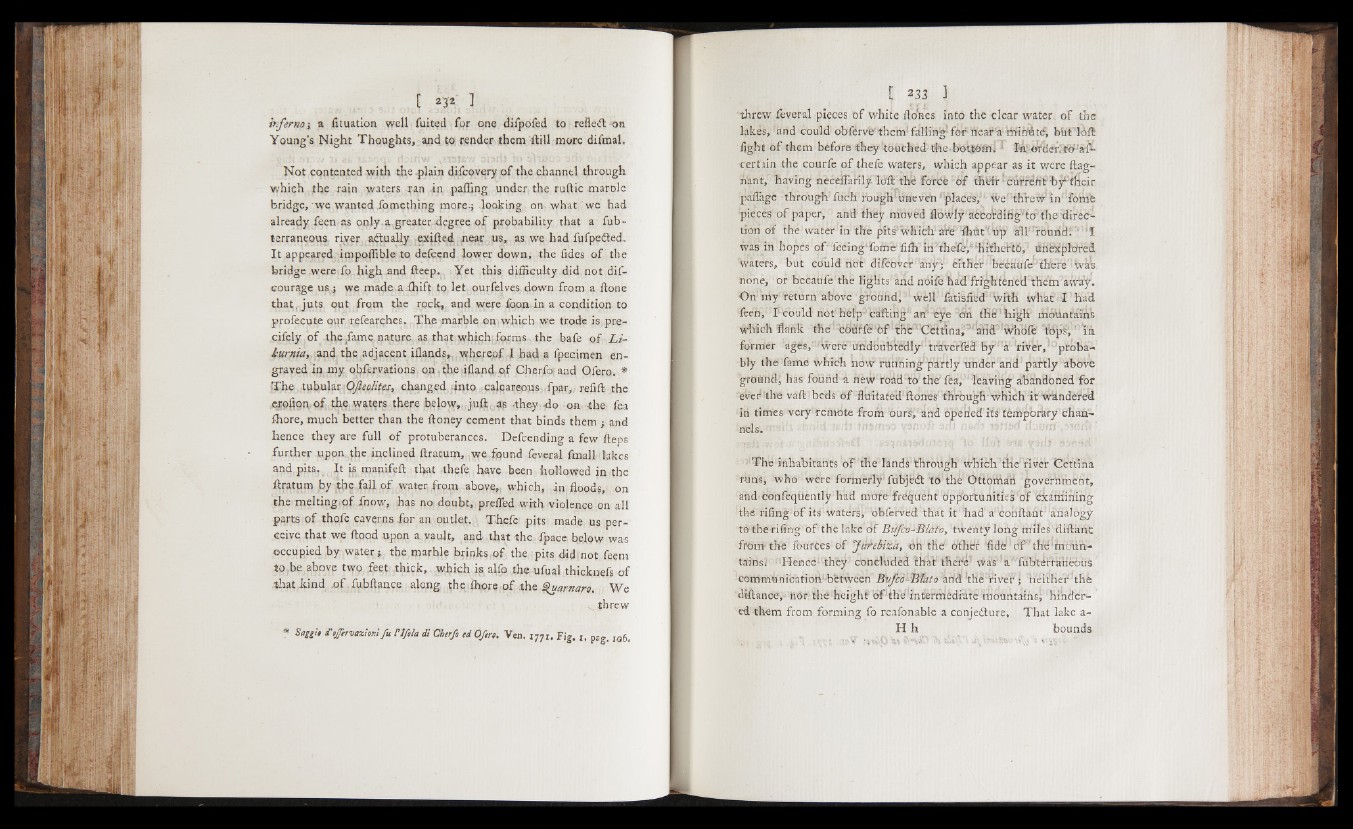
infernoj a fituation well fuited for one difpofed to refledt on
Young’s Night Thoughts,, and to render them ftill more difmal.
Not contented with the-plain difcQvqry o f the channel through
which the rain waters ran in paffing under the ruftic marble
bridge, we wanted fomething more, looking on what we had
already feen as only a greater degree o f probability that a fub-
terraneous river actually exifted near us, as we had fufpedted.
It appeared impoffible to defcend lower down, the fides o f the
bridge .were fo high and deep. Yet this difficulty did not dif-
courage us ; we made a.lhift to let ourfelves down from a done
that, juts out from the rock, and were ibon, in a condition to
profecute our refearches. The marble on which we trode is.pre-
cifely o f thCjfame nature as that which .forms the bafe o f L i-
iurnia, and the adjacent iflandst wfherep£,I had a fpecimen engraved
in my oljfervations on . t;he .ifland, o f Cherlo and Ofero. *
The tubular Ofieolites, changed tjnto calcareous fpar, refill the
erofionof the waters there below, juft as -they -do on -the fea
ffiore, much better than the floney cement that binds them „ and
hence they are full of protuberances. Defcending a few fteps
further upon the inclined ftratum, we fpund feveral fmall lakes
and pits. It js manifeft that thefe have been hollowed in the
ftratum by the fall o f water from above,, which, an,floods,' on
the melting.of fnow, has no doubt, prefled with violence on all
parts o f thofe caverns for an outlet. Thefe pits made us perceive
that we flood upon a vault, a»d that the fpace below was
occupied by water; the marhle brinks,of the pits did not feern
to be above two feet thick, which is alfo the ufual thicknefs of
that kind o f fubftance along the ffiore o f the Quarnaro. We
» th r ew
* Saxgit d’tfiirvazioni fu rifila dl Chtrfi td Ofirt, Ven. 1771, Fig. 1, pag. ,<¡6.
threw feveral pieces o f white flones into the clear water, o f the
lakes,1 and could obférve1¡them1 falling! forneai&hrirrttd, bbt’ lòlt
light o f them before they touched the-bo Uè in.-J »VdeirtcraÁ-
certiin the courle o f thefe waters, which appear as it were ftag-
n'ant, having neceflanly lbft thfe foròè "ét thiflìr múrrefrthy^ffieir
paflàge through fuch rough'uneven ' places,'' we threw'in feme
piecés'of paper, and they moved flowíy'aétoídltíg'fldflhe'direc-
tioii of the water in the pits1 which aVe ibà rtup :aìl” rburidT‘ T
was ill hopes of'feeingToirie fiffi in thefe;fcffiíihettó, üriésphÜéá
waters, but could riot difebver'aiijry either bdéadfe^'there Was
none, or becaufe the lights!ánd nóife had frighferieH theln awtf^.
On niy ‘return above ground; ‘well fatisfied with what I had
feen, 1 could not help-calling'an eye on thè’1 high mountains
which flank the cítáfíiróf 4Sré-‘Cemnaí3<!038.'lí$h<Jfe' typ¥;, ! 'in
former 'dges,: 'weréundbdbtédly' tráveríeá b y a 'river,'1 probably
the fame Which how rurihing,;paftly under arid partly above
grOUtld; has found a hew rcíáü to the' lea, fedVing abandoned for
evertthe vafl beds o f Undated flones’ thtbugfi which it wandered
iti times very remote from ourS, and operfed its temporary channels.
r:
The inhabitants o f the lands throiigh which tne^fiver Cetttna
rhnS; who were formerly fabjÉfét tfl’ thè' Ottòtìriah govbrtì'mèht,
and coníeqüently had mchéfrd¿jüént ó'ppbrtúriitíesí’oF 'éxánfirflh'g
the rifing of its waters, 'obferved that it 'had"a“cohftànt' 'analogy
to the riling 'of the lake of Bufco-Blàto, tWehty long miles diftant
from- the fources o f faiebiza, oh the other 'fidé cF'the'moUri-
ta'insí "HenedKthey concludèd that thehe5 wa's'''a'''fiibt¿rtatíbóíiá
commririicatibh'bfetween Bìfcò^Bfa/o M a ttìl'r iv b F j n'éitheF 'thè
diftanoe^hor the height bf'èhe' .Ìnfcrm‘édiate hibarita-irisì híndér-
ed them from forming fo reafonable a conjedlure. That lake a-
H h bounds